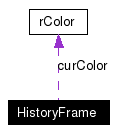
#include <historyframe.h>
Collaboration diagram for HistoryFrame:

Public Slots | |
| void | useColor () |
| void | delColor () |
Signals | |
| void | historySelected (const rColor &) |
| void | deleteColor (HistoryFrame *) |
Public Member Functions | |
| HistoryFrame (QWidget *parent=0, const char *name=0, WFlags f=0) | |
| void | setColor (const rColor &) |
| const rColor & | getColor () |
Protected Member Functions | |
| void | mouseReleaseEvent (QMouseEvent *) |
| void | resizeEvent (QResizeEvent *) |
Private Attributes | |
| rColor | curColor |
| QSize | pmSize |
| QPixmap | txt |
| QPixmap | fg |
| QPixmap | bg |
| QPopupMenu * | popper |
|
||||||||||||||||
|
The c'tor creates the frame and sets the current color to opaque white. The popup menu is initialized and connected here too. Here is the call graph for this function:  |
|
|
|
|
|
|
|
|
|
|
|
|
|
|
Reimplemented from QFrame. We assume here that a mouse button must have been clicked: Why else could we get a release event? Anyway, if it was the left button coming up we emit the signal historySelected(). This will work on every instance, allowing the selection of opaque white. The right button however is ignored if the current color is opaque white. If it isn't, we will pop up the popper and let it take over from here. |
|
|
The resizeEvent is reimplemented from QFrame. This is necessary to adapt the sizes of our pixmaps to the new geometry. To conclude this, we do a setColor() to enforce a repaint of the frame contents. Here is the call graph for this function:  |
|
|
Sets the current color to c. The background pixmap is freshly painted and applied to the widget. Here is the call graph for this function:  |
|
|
|
|
|
|
|
|
|
|
|
|
|
|
|
|
|
|
|
|
|